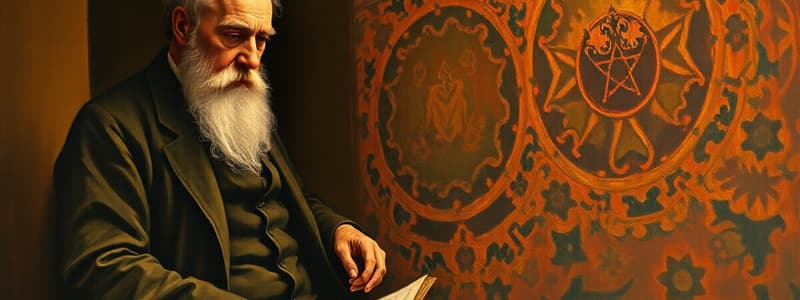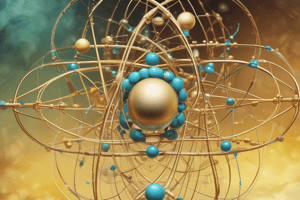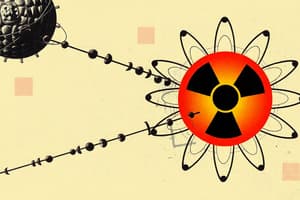Podcast
Questions and Answers
What was a significant contribution of Ernest Rutherford to the field of atomic science?
What was a significant contribution of Ernest Rutherford to the field of atomic science?
- The discovery of gamma radiation as a form of radioactive decay.
- The development of a detailed model of the atomic nucleus. (correct)
- The introduction of chemical bonding theories to explain atomic interactions.
- The identification of electrons as the primary building blocks of atoms.
Which of the following correctly describes the instrument used by Rutherford in his experiments?
Which of the following correctly describes the instrument used by Rutherford in his experiments?
- A sealed tube that employs electrodes to examine radioactivity. (correct)
- A prism designed to separate different wavelengths of radiation.
- A calorimeter used to measure the heat produced in radioactive decay.
- A spectrometer that analyzes the mass of alpha particles.
What element did Rutherford successfully convert into another through his transmutation experiments?
What element did Rutherford successfully convert into another through his transmutation experiments?
- Nitrogen into Oxygen. (correct)
- Carbon into Helium.
- Oxygen into Nitrogen.
- Hydrogen into Lithium.
Which type of radiation is characterized as positively charged and relatively heavy?
Which type of radiation is characterized as positively charged and relatively heavy?
In the context of Rutherfold's discoveries, what does the term 'radioactivity' refer to?
In the context of Rutherfold's discoveries, what does the term 'radioactivity' refer to?
What was a key observation from Rutherford's gold foil experiment?
What was a key observation from Rutherford's gold foil experiment?
What conclusion did Rutherford draw about the structure of the atom?
What conclusion did Rutherford draw about the structure of the atom?
In the experimental setup, how were the positively charged particles represented?
In the experimental setup, how were the positively charged particles represented?
Which statement accurately describes the behavior of some of the particles during the experiment?
Which statement accurately describes the behavior of some of the particles during the experiment?
What did the results of Rutherford's experiment suggest about the arrangement of electrons?
What did the results of Rutherford's experiment suggest about the arrangement of electrons?
What key conclusion did Rutherford make about the structure of the atom after his experiments?
What key conclusion did Rutherford make about the structure of the atom after his experiments?
Which model of the atom did Rutherford's findings challenge?
Which model of the atom did Rutherford's findings challenge?
What did Bohr introduce to the understanding of atomic structure?
What did Bohr introduce to the understanding of atomic structure?
Which discovery is attributed to Rutherford from his research?
Which discovery is attributed to Rutherford from his research?
What did Rutherford use in his experiments to probe the structure of the atom?
What did Rutherford use in his experiments to probe the structure of the atom?
How did Rutherford describe the atom in his 1911 model?
How did Rutherford describe the atom in his 1911 model?
Which synthetic element is named after Ernest Rutherford?
Which synthetic element is named after Ernest Rutherford?
Which particle was identified as the building block of all elements by Rutherford?
Which particle was identified as the building block of all elements by Rutherford?
What key aspect of atomic structure did Niels Bohr contribute to in 1913?
What key aspect of atomic structure did Niels Bohr contribute to in 1913?
Which of the following best describes Rutherford's experiment with gold foil?
Which of the following best describes Rutherford's experiment with gold foil?
What did Rutherford and his team discover when light elements were bombarded with alpha particles?
What did Rutherford and his team discover when light elements were bombarded with alpha particles?
What significant conclusion did Rutherford's work lead to regarding atomic structure?
What significant conclusion did Rutherford's work lead to regarding atomic structure?
Which particle was proposed by Rutherford to exist alongside protons within the nucleus?
Which particle was proposed by Rutherford to exist alongside protons within the nucleus?
In what year did James Chadwick identify the neutron?
In what year did James Chadwick identify the neutron?
What aspect of John Dalton's atomic theory did Rutherford's findings contradict?
What aspect of John Dalton's atomic theory did Rutherford's findings contradict?
What element was named in honor of Rutherford for his contributions to the field of science?
What element was named in honor of Rutherford for his contributions to the field of science?
Flashcards
Alpha Particles
Alpha Particles
Positively charged particles emitted during radioactive decay.
Beta particles
Beta particles
Negatively charged particles emitted during radioactive decay.
Transmutation
Transmutation
The process of converting one element into another.
Ernest Rutherford
Ernest Rutherford
Signup and view all the flashcards
Rutherford Model
Rutherford Model
Signup and view all the flashcards
Rutherford's Gold Foil Experiment
Rutherford's Gold Foil Experiment
Signup and view all the flashcards
Most particles passed straight through
Most particles passed straight through
Signup and view all the flashcards
Some particles were deflected
Some particles were deflected
Signup and view all the flashcards
A small number of particles bounced back
A small number of particles bounced back
Signup and view all the flashcards
What is the nucleus?
What is the nucleus?
Signup and view all the flashcards
Atomic Nucleus
Atomic Nucleus
Signup and view all the flashcards
Proton
Proton
Signup and view all the flashcards
Electron
Electron
Signup and view all the flashcards
Gold Foil Experiment
Gold Foil Experiment
Signup and view all the flashcards
Electron Shells
Electron Shells
Signup and view all the flashcards
Electron Transitions
Electron Transitions
Signup and view all the flashcards
Rutherfordium
Rutherfordium
Signup and view all the flashcards
Bohr's Model of the Atom
Bohr's Model of the Atom
Signup and view all the flashcards
Plum Pudding Model
Plum Pudding Model
Signup and view all the flashcards
Proton Discovery
Proton Discovery
Signup and view all the flashcards
Rutherford's Model of the Atom
Rutherford's Model of the Atom
Signup and view all the flashcards
Rutherford's Experiment with Alpha Particles
Rutherford's Experiment with Alpha Particles
Signup and view all the flashcards
The Neutron's Existence
The Neutron's Existence
Signup and view all the flashcards




